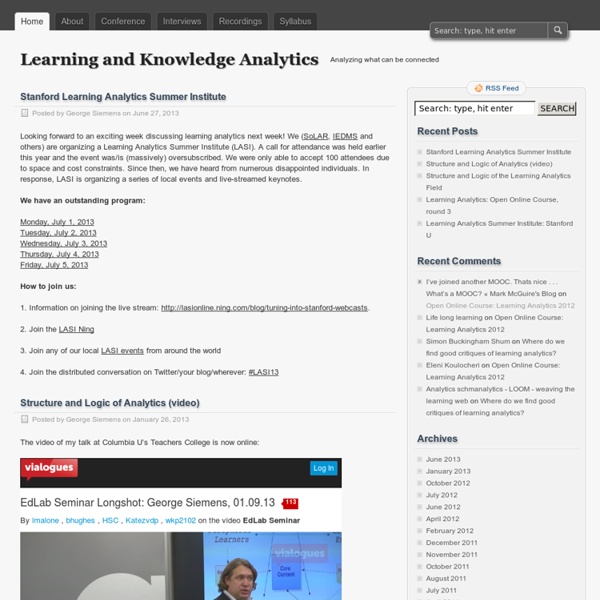



Adam Cooper’s Work Blog » A Seasonal Sociogram for Learning Analytics Research SoLAR, the Society for Learning Analytics Research has recently made available a dataset covering research publications in learning analytics and educational data mining and issued the LAK Data Challenge, challenging the community to use the dataset to answer the question: What do analytics on learning analytics tell us? How can we make sense of this emerging field’s historical roots, current state, and future trends, based on how its members report and debate their research? Thanks to too many repeats on the TV schedule I managed to re-learn a bit of novice-level SPARQL and manipulate the RDF/XML provided into a form I can handle with R. Now, I’ve had a bit of a pop at the sociograms – i.e. visualisations of social networks – in the past but they do have their uses and one of these is getting a feel for the shape of a dataset that deals with relations. And with it being the Christmas season, the colour scheme chose itself. So, what does it tell me? Am I any the wiser? Merry Christmas!
Analytics Training Learning data visualization I listen to a lot of podcasts. They make my workouts much more enjoyable. For the most part though, I only listen to ones about sports and more general podcasts about design, technology, and working from home. Neither had experience producing podcasts before this, so it was rough around the edges at first. In the most recent episode, with Andy Kirk, they discuss the most common question from people new to the field: how to get started. One thing I'd add (that maybe I missed as cars drove past me) is that it's important to establish what you want to learn visualization for. Learn/Visualization - Galaxy Wiki Visualization in Galaxy Trackster is Galaxy's visualization and visual analysis environment. It lets you visualize your SAM/BAM, BED, GFF/GTF, WIG, bigWig, bigBed, bedGraph, and VCF datasets from within Galaxy. Why Trackster? Fast, interactive visualization for large, NGS/HTS datasets using only a Web browser. Getting Started Click on Visualization --> New Track Browser in the top menu bar.Choose a build and name for the visualization. Viewing a specific location Click the text showing the current region. Enter the desired region with the format: chrom: start-end. You can use the mouse to change chroms/contigs using the dropdown.Dragging anywhere in the main window will pan the view.Double clicking anywhere in the main window will zoom in at the location of the mouse click.There are zoom-in and zoom-out icons on the toolbar.You can drag a region within the location track to view that region, as shown in the following image: You can use the arrow keys on your keyboard to pan the view. Display
Learning & Knowledge Analytics 2011 Introduction to Learning and Knowledge AnalyticsAn Open Online CourseJanuary 10-February 20, 2011www.learninganalytics.net Technology Enhanced Knowledge Research Institute, Athabasca University This work is licensed under a Creative Commons Attribution-NonCommercial-ShareAlike 3.0 Unported License. Credit This is an open (and free) course offered by the Technology Enhanced Knowledge Research Institute (TEKRI) at Athabasca University. Course Description The growth of data surpasses the ability of organizations or individuals to make sense of it. Learning analytics can play a role in highlighting the development of employees through their learning activities. Learning and Knowledge Analytics 2011 is a conceptual and exploratory introduction to the role of analytics in learning and knowledge development. Course Tag #LAK11 (for Diigo, Twitter, blogs, Delicious) Course Outcomes As a result of active participation throughout this course, participants can expect to: Important Links Getting Started: